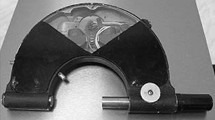Abstract
The design of an instrument is described that measures three resultant force components and three resultant moment components acting on a surface. Within the framework of linear elastostatics of an isotropic homogeneous material the device separates to a given precision the six resultant load components. Sensor paths of finite length are employed. Moreover if fiber-optic differential displacement sensors are used rather than traditional electrical resistance strain gages, the range and sensitivity of the instrument can in principle be improved without sacrificing the device stiffness. The primary reason for these improvements is that a complete solution to the equations of elasticity allows certain displacements to be measured over large distances and be combined to yield all of the resultant load components. These displacement measurements over a long distance accommodates the use of fiber-optic interferometric sensors. The use of optical sensors in contrast with electrical-resistance gages, has the potential to allow the measurement precision and range to scale with the geometry of the device rather than the maximum strain in the instrument. It becomes possible by virtue of these features to produce a better instrument.
Similar content being viewed by others
References
Quinn, T.P. andMote, C.D., “Optimal Design of an Uncoupled Six Degree of Freedom Dynanometer,” EXPERIMENTAL MECHANICS,20 (1),40–48 (March1990).
Molland, A.F., “A Five-component Strain Gauge Wind Tunnel Dynamometer,” Strain, 7–13 (Jan. 1978).
Dally, James W. andRiley, William F., Experimental Stress Analysis, McGraw-Hill, New York, Chap. 6 (1978).
Holmes, J.E., “Static Multiple-Load Measurement Technique as Utilized in the Naval Surface Weapons Center's Wind Tunnels,” Tech. Rep. of the Naval Surface Weapons Center 76-26, White Oak, Silver Spring, MD (April 30, 1976).
Timoshenko, S.P. andGoodier, J.N., Theory of Elasticity, 3rd Ed., McGraw-Hill, New York (1970).
Butter, C.D. andHocker, G.B., “Fiber Optics Strain Gauge,”Appl. Opt.,17 (18),2867–2869 (1978).
Sokolnikoff, I.S., Mathematical Theory of Elasticity, Krieger Publishing, Malabar, FL 91-248 (1956).
Sechler, E.E., Elasticity in Engineering, Dover, New York, Section 8.2 (1952).
Peekel, C., “Do We Measure Strain When We Measure Strain?,” Strain, 112–116 (July 1972).
Baker, Donald G., Monomode Fiber-Optic Design with Local-Area and Long-Haul Network Applications, Van Nostrand Reinhold, New York (1987).
Fiber Optic Sensors An Introduction for Engineers and Scientists, ed. E. Udd, John Wiley and Sons Inc., New York (1991).
Sirkis, J.S., and Taylor, C.E., “Interferometric-fiber-optic Strain Sensor,” EXPERIMENTAL MECHANICS,170–176 (June 1988).
Sirkis, J.S. andHaslach, H.W., “Interferometric Strain Measurement by Arbitrarily Configured, Surface-mounted, Optical Fibers,”J. Lightwave Tech.,8 (10),1497–1503 (Oct.1990).
Gross, W.C., Goldstein, R., Nelson, M.D., Fearnehaugh, H.T. andRamer, O.G., “Fiber-optic Rotation Sensor Technology,”Appl. Opt.,19 (6),852–858 (1980).
Kim, B.Y. andShaw, H.J., “Phase-reading All-fiber-optic Gyroscope,”Opt. Let.,9 378 (1984).
Murphy, K.A., Miller, M.S., Vengsarkar, A.M. andClaus, R.O., “Elliptical-Core Two-Mode Optical-Fiber Sensor Implementation Methods,”J. Lightwave Tech.,8 (11),1688–1696 (Nov.1990).
Gradshteyn, I.S. andRyzhik, I.M., Tables of Integrals, Series, and Products (Corrected and Enlarged Edition),Academic Press, New York (1980).
Shupe, D.M. “Fiber Resonator Gyroscope: Sensitivity and Thermal Nonreciprocity,”Appl. Opt.,20 (2),287 (Jan.1981).
Author information
Authors and Affiliations
Rights and permissions
About this article
Cite this article
Washabaugh, P.D. A precision six-load-component transducer: A design incorporating finite-length measurement paths. Experimental Mechanics 33, 326–335 (1993). https://doi.org/10.1007/BF02322149
Received:
Revised:
Issue Date:
DOI: https://doi.org/10.1007/BF02322149




